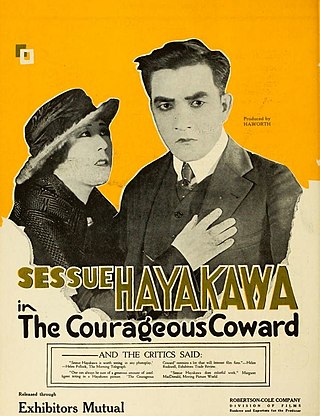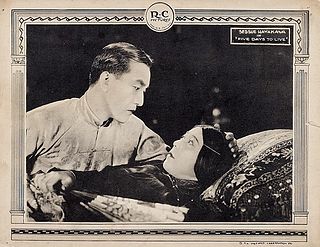
Kintarō Hayakawa, known professionally as Sessue Hayakawa, was a Japanese actor and a matinée idol. He was a popular star in Hollywood during the silent film era of the 1910s and early 1920s. Hayakawa was the first actor of Asian descent to achieve stardom as a leading man in the United States and Europe. His "broodingly handsome" good looks and typecasting as a sexually dominant villain made him a heartthrob among American women during a time of racial discrimination, and he became one of the first male sex symbols of Hollywood.

Marin Sais was an American actress whose career was most prolific during the silent film era of the 1910s and 1920s. Sais' acting career spanned over four decades and she is possibly best recalled for appearing in Western themed films.
The Slanted Screen is a 2006 documentary film written, produced, and directed by Jeff Adachi which examines the stereotypical portrayals and absence of East Asian males in the cinema of the United States. The film analyzes Hollywood from the silent era to the 21st century.

Three Came Home is a 1950 American World War II film directed by Jean Negulesco, based on the memoirs of the same name by writer Agnes Newton Keith. It depicts Keith's life in North Borneo in the period immediately before the Japanese invasion in 1942, and her subsequent internment and suffering, separated from her husband Harry, and with a young son to care for. Keith was initially interned at Berhala Island near Sandakan, North Borneo but spent most of her captivity at Batu Lintang camp at Kuching, Sarawak. The camp was liberated in September 1945.

Richard Loo was an American film actor who was one of the most familiar Asian character actors in American films of the 1930s and 1940s. He appeared in more than 120 films between 1931 and 1982.

The Dragon Painter is a 1919 English language silent romance drama film. It is based on the novel of the same name, written by Mary McNeil Fenollosa. It stars Sessue Hayakawa as a young painter who believes that his fiancée, is a princess who has been captured and turned into a dragon. It was directed by William Worthington and filmed in Yosemite Valley, Yosemite National Park, and in the Japanese Tea Garden in Coronado, California.

The Vermilion Pencil is a 1922 American silent drama film directed by Norman Dawn, and produced and distributed by Robertson–Cole. It is based on the eponymous 1908 novel by Homer Lea. The film stars Japanese actor Sessue Hayakawa in multiple roles, and white actors Ann May, Bessie Love, and Sidney Franklin, all in Asian roles. It is now a lost film.

Lilies of the Field is a 1924 American silent drama film directed by John Francis Dillon, produced by and starring actress Corinne Griffith, and distributed by Associated First National Pictures. It is based on a 1921 play, Lilies of the Field, by William J. Hurlbut. The film was remade by Griffith as an early sound film in 1930.

The Soul of Kura San is a 1916 American drama silent film directed by Edward LeSaint and written by Charles Sarver. The film stars Sessue Hayakawa, Myrtle Stedman, Tsuru Aoki, George Webb, Kisaburo Kurihara and George Kuwa. The film was released on October 30, 1916, by Paramount Pictures.

The Call of the East is a 1917 American silent drama film directed by George Melford and written by Beulah Marie Dix. The film stars Sessue Hayakawa, Tsuru Aoki, Jack Holt, Margaret Loomis, James Cruze, and Ernest Joy. The film was released on October 15, 1917, by Paramount Pictures.

The Courageous Coward is a 1919 American silent drama film directed by William Worthington and featuring Sessue Hayakawa and Tsuru Aoki in lead roles.

The Gray Horizon is a 1919 American silent drama film directed by William Worthington. Sessue Hayakawa's Haworth Pictures Corporation produced the film and he himself played the lead role. Bertram Grassby, Tsuru Aoki, Eileen Percy, Mary Jane Irving, and Andrew Robson also featured in the film.

Bonds of Honor is a 1919 American silent film directed by William Worthington. Sessue Hayakawa's Haworth Pictures Corporation produced the film and he himself played the leading roles along with his wife Tsuru Aoki. Marin Sais, Dagmar Godowsky, Herschel Mayall, Toyo Fujita and M. Foshida also appeared in the film.

Five Days to Live is a 1922 American silent drama film directed by Norman Dawn and featuring Sessue Hayakawa, Tsuru Aoki, Goro Kino, Misao Seki, Toyo Fujita, and George Kuwa.

Night Life in Hollywood, called The Shriek of Hollywood in Europe, is a 1922 American silent comedy film directed by Fred Caldwell. It starred J. Frank Glendon, Josephine Hill, and Gale Henry, and featured a number of cameo appearances of celebrities with their families.

Gina Palerme was a French actress and dancer.

The Old Swimmin' Hole is a 1921 American silent comedy film directed by Joe De Grasse based on the poem The Old Swimmin' Hole by James Whitcomb Riley. A reviewer for Exhibitors Herald summarized, "The theme of the picture is a light one—just the pleasant little love story of a country schoolboy and girl in the era of the youth of Tom Sawyer."

Where Lights Are Low is a 1921 American silent drama film directed by Colin Campbell and starring Sessue Hayakawa, Tôgô Yamamoto, and Goro Kino.
Toyo Fujita was a Japanese actor who worked in Hollywood from the late 1910s through the mid-1930s.

















